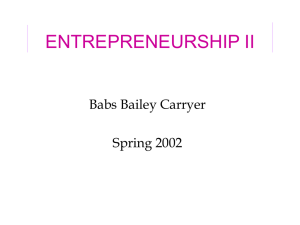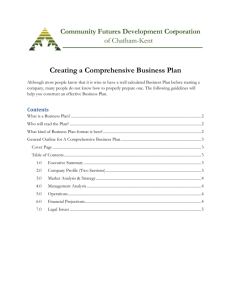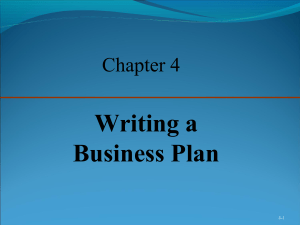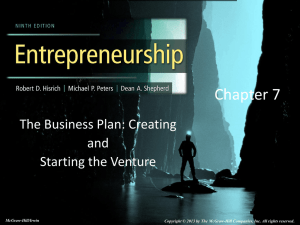Timmons Ch 12 Lecture Notes 6e
advertisement
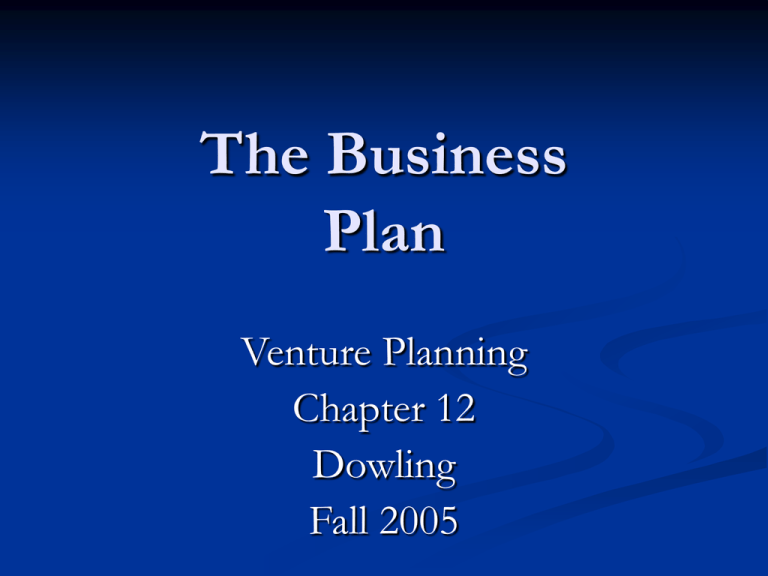
The Business Plan Venture Planning Chapter 12 Dowling Fall 2005 The Business Plan The Business Plan Carefully articulates the merits, requirements, risks, and potential rewards of the opportunity and how it will be seized. The Business Plan The Four Anchors (See Chap. 4) Create or add significant value to a customer or end user. Solve a significant problem or meet a significant want or need, for which someone is willing to pay a premium. Have robust market, margin and money-making characteristics. A good fit with the founder(s) and management team at the time and marketspace, and with the risk/reward balance. The Business Plan The plan is not the business, but… The vast majority of INC.’s 500 fastest-growing companies had business plans at the outset. Don’t confuse the plan and building the business. Unless the fundamental opportunity is there, along with the requisite resources and team needed to pursue it, the best plan in the world won’t make much difference. The Business Plan ‘Tips from the trenches’ Stress your business concept in the executive summary The numbers don’t matter; but the economics (e.g., value proposition and value model) really matter. The Business Plan Do’s and Don’ts Do Make plan logical, comprehensive, and readable – and short. Articulate what the critical risks and assumptions are and how and why these are tolerable. Remember that the plan is not the business and that an ounce of ‘can-do implementation’ is worth two pounds of planning Let realistic market and sales projections drive the assumptions underlying the financial spreadsheets, not vice-versa. The Business Plan Do’s and Don’ts Don’t Describe technical products or manufacturing processes using jargon or in a way that only an expert can understand, because this limits the usefulness of the plan. Spend money on developing fancy brochures, elaborate slide show presentations and other “sizzle.” Instead, show the “steak.” The Business Plan Know your stuff “Investors attach great importance to the quality of the management team and to their complete understanding of the business they are preparing to enter.” “There is a great difference between screening an opportunity and developing a business plan.” The Business Plan Executive Summary Description of the business concept and the business The opportunity and strategy The target market and projections The competitive advantages The economics, profitability, and harvest potential The team The offering The Business Plan The Industry and the Company and its Products or Services The industry The company and the concept The product(s) or service(s) Entry and growth strategy The Business Plan Market research and analysis Note: DO THIS STEP FIRST And, information in this section needs to support the assertion that the venture can capture a substantial market share in a growing market in the face of competition. The Business Plan Market Research & Analysis Customers Market size and trends Competition and competitive edges Estimated market share and sales Ongoing market evaluation The Business Plan The Economics of the Business Gross and operating margins Profit potential and durability Fixed, variable and semivariable costs Months to breakeven Months to reach positive cash flow The Business Plan Marketing Plan Overall marketing strategy Pricing Sales tactics Service & warranty policies Advertising and promotion Distribution The Business Plan Design & Development Plans Development status and tasks Difficulties and risks Product improvement and new products Costs Proprietary issues The Business Plan Manufacturing and Operations Plan Operating cycle Geographical location Facilities and improvements Strategy and plans Regulatory and legal issues The Business Plan Management Team Organization Key management personnel Management compensation and ownership Other investors Employment and other agreements and stock option and bonus plans Board of directors Other shareholders, rights and restrictions Supporting professional advisors and services The Business Plan Overall Schedule Step 1 - Lay out cash conversion cycle Step 2 – Prepare a month-by-month schedule that shows the timing of such activities as product development, market planning, sales promotions, production, and operations Step 3 – Show on the schedule the deadlines or milestones critical to the venture’s success Step 4 – Show on the schedule the “ramp-up” of the number of management personnel Step 5 – Discuss in a general way the activities most likely to cause a schedule slippage The Business Plan Critical Risks, Problems and Assumptions Identifying the risks in your venture demonstrates your skills as a manager Discuss assumptions and risks implicit in your plan Identify and discuss any major problems and other risks Indicate what assumptions or potential problems and risks are most critical to the venture’s success The Business Plan The Financial Plan Actual income statements and balance sheets Pro-forma income statements Pro-forma balance sheets Pro-forma cash flow analysis Break-even chart Cost control Highlights The Business Plan Proposed Company Offering Desired financing Offering Capitalization Use of funds Investors’ return The Business Plan Appendixes Include pertinent information here that is too extensive for the body of the business plan but which is necessary
